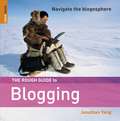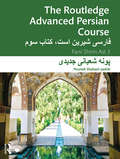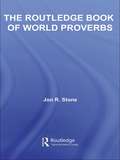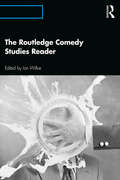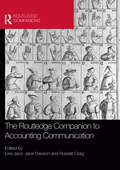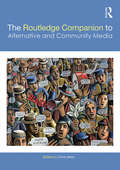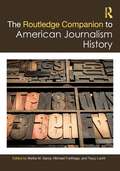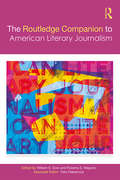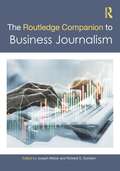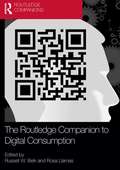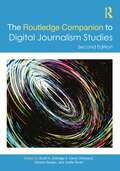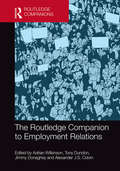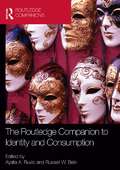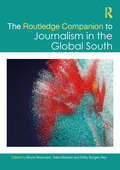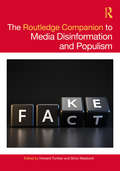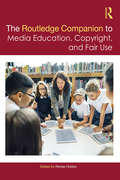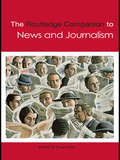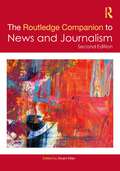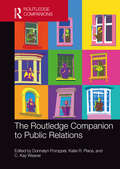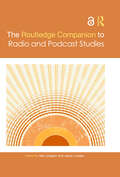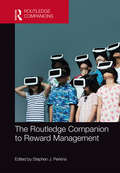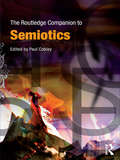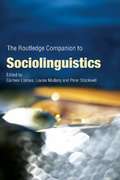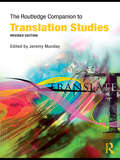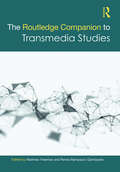- Table View
- List View
The Rough Guide to Blogging
by Jonathan YangThe Rough Guide to Blogging is the ultimate reference for all things weblog. It takes you into the blogosphere, from blogging's early history and where it is today, to the future of blogs and their social and cultural impact. This book will help you to discover the greatest blogs on the web and to understand newsreaders and RSS. Whether you want to start your own blog or contribute to an existing one, this guide will teach you everything you'll need to know. Chapters include: Creating a Blog, Blog Design, Advanced Blogging, Audio and Video, Podcasting, Blogging for Money, Corporate Blogging plus much, much more. Whether you're an experienced blogger or just getting started, this is the right book for you.
The Routledge Advanced Persian Course: Farsi Shirin Ast 3
by Pouneh Shabani-JadidiThe Routledge Advanced Persian Course: Farsi Shirin Ast 3 aims to help students of higher-level proficiency continue elevating their proficiency level to achieve near-native level. Key features include: Authentic texts on a variety of topics related to Iran’s history, geography, arts, literature, culture, religions, society, and people. Each lesson includes a prominent poet and their most representative poem familiarizing students with the Persian literary canon, while indirectly learning the higher order registers used in the language of poetry. Lessons end with a Persian proverb and the story behind it, so that students will not only master the language but also the culture of the language and reach a near-native level of linguistic and cultural proficiency. The proverbs and some of the classical poetry are written in the calligraphy form to make students get used to reading handwritten texts resembling calligraphy. Audio files are provided so that learners who are studying on their own can have access to correct pronunciations. This textbook continues the series from The Routledge Intermediate Course in Persian and is ideal for Advanced or B2-C1 level students of Persian.
The Routledge Book of World Proverbs
by Jon R. StoneThe Routledge Book of World Proverbs invites the reader to travel the globe in search of the origins of such words of wisdom, experiencing the rich cultural traditions reflected in each nation’s proverbs. This collection contains over 16,000 gems of humour and pathos that draw upon themes from our shared experiences of life. And we are not just invited to learn about other cultures; proverbs are ‘bits of ancient wisdom’ and thus teach us about our own history. Drawing together proverbs that transcend culture, time and space to provide a collection that is both useful and enjoyable, The Routledge Book of World Proverbs is, unquestionably, a book of enduring interest.
The Routledge Comedy Studies Reader
by Ian WilkieThe Routledge Comedy Studies Reader is a selection of the most outstanding critical analysis featured in the journal Comedy Studies in the decade since its inception in 2010. The Reader illustrates the multiple perspectives that are available when analysing comedy. Wilkie’s selections present an array of critical approaches from interdisciplinary scholars, all of whom evaluate comedy from different angles and adopt a range of writing styles to explore the phenomenon. Divided into eight unique parts, the Reader offers both breadth and depth with its wide range of interdisciplinary articles and international perspectives. Of interest to students, scholars, and lovers of comedy alike, The Routledge Comedy Studies Reader offers a contemporary sample of general analyses of comedy as a mode, form, and genre.
The Routledge Companion to Accounting Communication (Routledge Companions in Business, Management and Accounting)
by Russell Craig Lisa Jack Jane DavisonOne of the prime purposes of accounting is to communicate and yet, to date, this fundamental aspect of the discipline has received relatively little attention. The Routledge Companion to Accounting Communication represents the first collection of contributions to focus on the power of communication in accounting. The chapters have a shared aim of addressing the misconception that accounting is a purely technical, number-based discipline by highlighting the use of narrative, visual and technological methods to communicate accounting information. The contents comprise a mixture of reflective overview, stinging critique, technological exposition, clinical analysis and practical advice on topical areas of interest such as: The miscommunication that preceded the global financial crisis The failure of sustainability reporting The development of XBRL How to cut clutter With an international coterie of contributors, including a communication theorist, a Big Four practitioner and accounting academics, this volume provides an eclectic array of expert analysis and reflection. The contributors reveal how accounting communications represent, or misrepresent, the financial affairs of entities, thus presenting a state-of-the-art assessment on each of the main facets of this important topic. As such, this book will be of interest to a wide range of readers, including: postgraduate students in management and accounting; established researchers in the fields of both accounting and communications; and accounting practitioners.
The Routledge Companion to Alternative and Community Media (Routledge Media and Cultural Studies Companions)
by Chris AttonThe Routledge Companion to Alternative and Community Media provides an authoritative and comprehensive examination of the diverse forms, practices and philosophies of alternative and community media across the world. The volume offers a multiplicity of perspectives to examine the reasons why alternative and community media arise, how they develop in particular ways and in particular places, and how they can enrich our understanding of the broader media landscape and its place in society. The 50 chapters present a range of theoretical and methodological positions, and arguments to demonstrate the dynamic, challenging and innovative thinking around the subject; locating media theory and practice within the broader concerns of democracy, citizenship, social exclusion, race, class and gender. In addition to research from the UK, the US, Canada, Europe and Australia, the Companion also includes studies from Colombia, Haiti, India, South Korea and Zimbabwe, enabling international comparisons to be made and also allowing for the problematisation of traditional - often Western - approaches to media studies. By considering media practices across a range of cultures and communities, this collection is an ideal companion to the key issues and debates within alternative and community media.
The Routledge Companion to American Journalism History (Routledge Media and Cultural Studies Companions)
by Tracy Lucht Melita M. Garza Michael FuhlhageThe Routledge Companion to American Journalism History revisits media history across forms, formats, and multiple fault lines, including gender, ethnicity, race, and citizenship status. Original contributions highlight areas of journalism history in desperate need of further treatment, with a special focus on diversity, equity, and accountability. Sections cover the early origins and development of journalism in the United States, pivotal moments and personalities in various strands of journalism, underrepresented groups and formats in journalism history, and key issues in "doing" journalism history. Authors aim to fill in the gaps left by traditional historical narratives by examining overlooked subjects, such as labor reporting, and overdue theoretical perspectives, such as intersectionality. Collectively, the voices in this book offer a more inclusive paradigm for the field. Written by a range of recognized journalism scholars, both well-established and emerging, this collection offers a thought-provoking starting point for researchers and advanced students seeking a critical understanding of American journalism history as conceived in the current era.
The Routledge Companion to American Literary Journalism (Routledge Media and Cultural Studies Companions)
by William E. Dow Roberta MaguireTaking a thematic approach, this new companion provides an interdisciplinary, cross-cultural, and international study of American literary journalism.From the work of Frederick Douglass and Walt Whitman to that of Joan Didion and Dorothy Parker, literary journalism is a genre that both reveals and shapes American history and identity. This volume not only calls attention to literary journalism as a distinctive genre but also provides a critical foundation for future scholarship. It brings together cutting-edge research from literary journalism scholars, examining historical perspectives; themes, venues, and genres across time; theoretical approaches and disciplinary intersections; and new directions for scholarly inquiry. Provoking reconsideration and inquiry, while providing new historical interpretations, this companion recognizes, interacts with, and honors the tradition and legacies of American literary journalism scholarship. Engaging the work of disciplines such as sociology, anthropology, African American studies, gender studies, visual studies, media studies, and American studies, in addition to journalism and literary studies, this book is perfect for students and scholars of those disciplines.
The Routledge Companion to Business Journalism (Routledge Media and Cultural Studies Companions)
by Joseph Weber Richard S. DunhamThe Routledge Companion to Business Journalism provides a complete and critical survey of the field of business and economic journalism. Beginning by exploring crucial questions of the moment, the volume goes on to address such topics as the history of the field; differentiation among business journalism outlets; issues and forces that shape news coverage; globalism; personal finance issues; and professional concerns for practicing business journalists. Critical perspectives are introduced, including: gender and diversity matters on the business news desk and in business news coverage; the quality of coverage, and its ideological impact and framework; the effect of the internet on coverage; differences in approaches around the world; ethical issues; and education among journalists. Contributions are drawn from around the world and include work by leading names in the industry, as well as accomplished and rising-star academics. This book is an essential companion to advanced scholars and researchers of business and financial journalism as well as those with overlapping interests in communications, economics, and sociology.
The Routledge Companion to Digital Consumption (Routledge Companions in Business, Management and Accounting)
by Russell W. Belk Rosa LlamasThe first generation that has grown up in a digital world is now in our university classrooms. They, their teachers and their parents have been fundamentally affected by the digitization of text, images, sound, objects and signals. They interact socially, play games, shop, read, write, work, listen to music, collaborate, produce and co-produce, search and browse very differently than in the pre-digital age. Adopting emerging technologies easily, spending a large proportion of time online and multitasking are signs of the increasingly digital nature of our everyday lives. Yet consumer research is just beginning to emerge on how this affects basic human and consumer behaviours such as attention, learning, communications, relationships, entertainment and knowledge. The Routledge Companion to Digital Consumption offers an introduction to the perspectives needed to rethink consumer behaviour in a digital age that we are coming to take for granted and which therefore often escapes careful research and reflective critical appraisal.
The Routledge Companion to Digital Journalism Studies (Routledge Journalism Companions)
by Scott A. Eldridge David Cheruiyot Sandra Banjac Joëlle SwartThis second edition of The Routledge Companion to Digital Journalism Studies offers a truly global and groundbreaking collection of essays addressing the key issues and debates shaping the field of digital journalism studies today.Journalism has arguably faced unprecedented disruption and reconceptualization since the first edition of this Companion was published. Questions over what role journalism and journalists play in society are pervasive, and changes to platforms, products, practices, and audiences are among the forces driving a new research agenda in the field. This newly reorganized second edition addresses developments in technologies, data infrastructures, algorithms, and the businesses behind these technologies, as well as the impact of such developments on the practice of digital journalism. Debates concerning the decline of public trust in journalism, and the blurred distinctions between journalism and other forms of media and communication are also considered. The chapters outline the need for digital competence and literacy within journalism and introduce new methodological approaches, including experimental and arts-based methods, computational methods, and collaborative work.Comprising 54 original essays from distinguished academics across the globe, this book showcases the rich diversity of work that continues to define the field of digital journalism studies and is an essential point of reference for students and researchers alike.
The Routledge Companion to Employment Relations (Routledge Companions in Business, Management and Accounting)
by Adrian Wilkinson Tony Dundon Jimmy Donaghey Alexander ColvinComprising five thematic sections, this volume provides a critical, international and interdisciplinary exploration of employment relations. It examines the major subjects and emerging areas within the field, including essays on institutional theory, voice, new actors, precarious work and employment. Led by a well-respected team of editors, the contributors examine current knowledge and debates within each topic, offering cutting-edge analysis and reflection. The Routledge Companion to Employment Relations is an extensive reference work that offers students and researchers an introduction to current scholarship in the longstanding discipline of employment relations. It will be an essential addition to library collections in business and management, law, economics, sociology and political economy.
The Routledge Companion to Identity and Consumption (Routledge Companions in Business, Management and Accounting)
by Russell W. Belk Ayalla A. Ruvio"Tell me what you eat, I'll tell you who you are," said Anthelme Brillat-Savarin. Today, "You are what you consume" is more apt. Barbara Krueger’s ironic twist of Descartes - "I shop therefore I am" - has lost its irony. Such phrases have become commonplace descriptions of our identity in the contemporary world. In our materialistic world it seems as if there is no debate that our consumption behaviour is fused with our self-identity - shaping it, changing it and often challenging it. The Routledge Companion to Identity and Consumption introduces the reader to state-of-the-art research, written by the world’s leading scholars regarding the interplay between identity and consumption. The book addresses the diverse issues regarding the ways identity affects our consumption behaviour and vice-versa and in doing so, presents a broad perspective on the dynamics of self-identity and consumption. With chapters discussing the theory, research and practical implications of these dynamics, including the way they change across our life span and their expression within different social, cultural and religious contexts, this book will be a valuable reference source for students and academics from a variety of disciplines.
The Routledge Companion to Journalism in the Global South (Routledge Media and Cultural Studies Companions)
by Saba Bebawi Bruce Mutsvairo Eddy Borges-ReyResponding to mounting calls to decenter and decolonize journalism, The Routledge Companion to Journalism in the Global South examines not only the deep-seated challenges associated with the historical imposition of Western journalism standards on constituencies of the Global South but also the opportunities presented to journalists and journalism educators if they choose to partake in international collaboration and education. This collection returns to fundamental questions around the meaning, value, and practices of journalism from alternative methodological, theoretical, and epistemological perspectives. These questions include: What really is journalism? Who gets to, and who is qualified to, define it? What role do ethics play? What are the current trends, challenges, and opportunities for journalism in the Global South? How is news covered, reported, written, and edited in non-Western settings? What can journalism players living and working in industrialized markets learn from their non-Western colleagues and counterparts, and vice versa? Contributors challenge accepted "universal" ethical standards while showing the relevance of customs, traditions, and cultures in defining and shaping local and regional journalism. Showcasing some of the most important research on journalism in the Global South and by journalists based in the Global South, this companion is key reading for anyone researching the principles and practices of journalism from a de-essentialized perspective.
The Routledge Companion to Media Disinformation and Populism (Routledge Media and Cultural Studies Companions)
by Silvio Waisbord Howard TumberThis companion brings together a diverse set of concepts used to analyse dimensions of media disinformation and populism globally. The Routledge Companion to Media Disinformation and Populism explores how recent transformations in the architecture of public communication and particular attributes of the digital media ecology are conducive to the kind of polarised, anti-rational, post-fact, post-truth communication championed by populism. It is both interdisciplinary and multidisciplinary, consisting of contributions from both leading and emerging scholars analysing aspects of misinformation, disinformation, and populism across countries, political systems, and media systems. A global, comparative approach to the study of misinformation and populism is important in identifying common elements and characteristics, and these individual chapters cover a wide range of topics and themes, including fake news, mediatisation, propaganda, alternative media, immigration, science, and law-making, to name a few. This companion is a key resource for academics, researchers, and policymakers as well as undergraduate and postgraduate students in the fields of political communication, journalism, law, sociology, cultural studies, international politics and international relations.
The Routledge Companion to Media Education, Copyright, and Fair Use (Routledge Media and Cultural Studies Companions)
by Renee HobbsMedia literacy educators rely on the ability to make use of copyrighted materials from mass media, digital media and popular culture for both analysis and production activities. Whether they work in higher education, elementary and secondary schools, or in informal learning settings in libraries, community and non-profit organizations, educators know that the practice of media literacy depends on a robust interpretation of copyright and fair use. With chapters written by leading scholars and practitioners from the fields of media studies, education, writing and rhetoric, law and society, library and information studies, and the digital humanities, this companion provides a scholarly and professional context for understanding the ways in which new conceptualizations of copyright and fair use are shaping the pedagogical practices of media literacy.
The Routledge Companion to News and Journalism (Routledge Media and Cultural Studies Companions)
by Stuart AllanThe Routledge Companion to News and Journalism presents an authoritative, comprehensive assessment of diverse forms of news media reporting – past, present and future. Including 60 chapters, written by an outstanding team of internationally respected authors, the Companion provides scholars and students with a reliable, historically informed guide to news media and journalism studies. The Companion has the following features: It is organised to address a series of themes pertinent to the on-going theoretical and methodological development of news and journalism studies around the globe. The focus encompasses news institutions, production processes, texts, and audiences. Individual chapters are problem-led, seeking to address ‘real world’ concerns that cast light on an important dimension of news and journalism – and show why it matters. Entries draw on a range of academic disciplines to explore pertinent topics, particularly around the role of journalism in democracy, such as citizenship, power and public trust. Discussion revolves primarily around academic research conducted in the UK and the US, with further contributions from other national contexts - thereby allowing international comparisons to be made. The Routledge Companion to News and Journalism provides an essential guide to key ideas, issues, concepts and debates, while also stressing the value of reinvigorating scholarship with a critical eye to developments in the professional realm. The paperback edition of this Companion includes four new chapters, focusing on news framing, newsmagazines, digital radio news, and social media. Contributors: G. Stuart Adam, Stuart Allan, Chris Atton, Brian Baresch, Geoffrey Baym, W. Lance Bennett, Rodney Benson, S. Elizabeth Bird, R. Warwick Blood, Tanja Bosch, Raymond Boyle, Bonnie Brennen, Qing Cao, Cynthia Carter, Anabela Carvalho, Deborah Chambers, Lilie Chouliaraki, Lisbeth Clausen, James R. Compton, Simon Cottle, Ros Coward, Andrew Crisell, Mark Deuze, Roger Dickinson, Wolfgang Donsbach, Mats Ekström, James S.Ettema, Natalie Fenton, Bob Franklin, Herbert J. Gans, Mark Glaser, Mark Hampton, Joseph Harker, Jackie Harrison, John Hartley, Alfred Hermida, Andrew Hoskins, Shih-Hsien Hsu, Dale Jacquette, Bengt Johansson, Richard Kaplan, Carolyn Kitch, Douglas Kellner, Larsåke Larsson, Justin Lewis, Jake Lynch, Mirca Madianou, Donald Matheson, Heidi Mau, Brian McNair, Kaitlynn Mendes, Máire Messenger Davies, Toby Miller, Martin Montgomery, Marguerite Moritz, Mohammed el-Nawawy, Henrik Örnebring, Julian Petley, Shawn Powers, Greg Philo, Stephen D. Reese, Barry Richards, David Rowe, Philip Seib, Jane B. Singer, Guy Starkey, Linda Steiner, Daya Kishan Thassu, John Tulloch, Howard Tumber, Silvio Waisbord, Gary Whannel, Andrew Williams, Barbie Zelizer
The Routledge Companion to News and Journalism (Routledge Media and Cultural Studies Companions)
by Stuart AllanThe Routledge Companion to News and Journalism brings together scholars committed to the conceptual and methodological development of news and journalism studies from around the world. Across 50 chapters, organized thematically over seven sections, contributions examine a range of pressing challenges for news reporting – including digital convergence, mobile platforms, web analytics and datafication, social media polarization, and the use of drones. Journalism’s mediation of social issues is also explored, such as those pertaining to human rights, civic engagement, gender inequalities, the environmental crisis, and the Black Lives Matter movement. Each section raises important questions for academic research, generating fresh insights into journalistic forms, practices, and epistemologies. The Companion furthers our understanding of why we have ended up with the kind of news reporting we have today – its remarkable strengths, the difficulties it faces, and how we might improve upon it for tomorrow. Completely revised and updated for its second edition, this volume is ideal for advanced undergraduates, postgraduates, researchers, and academics in the fields of news, media, and journalism studies.
The Routledge Companion to Public Relations (Routledge Companions in Marketing, Advertising and Communication)
by Donnalyn Pompper C. Kay Weaver Katie R. PlacePublic relations is a uniquely pervasive force in our modern economy, influencing every aspect of our lives from the personal to the political. This comprehensive volume provides an expert overview of current scholarship, reflecting the impact of technology, society, and demographic shifts in a complex global environment. The last century saw the emergence of the public relations discipline. This expertly curated collection explores the dynamic growth in thinking about public relations’ role in our changing global society, now and into the future. It reflects the challenges and perspectives of postcolonial, postmodern, feminist, critical race theory, social responsibility, sustainability, activist standpoints, as well as the profound and unpredictable impact of technological change and social media. Each chapter provides an overview of current knowledge and its roots, while engaging with emerging new directions and old debates – and advocates for where the research agenda is likely to advance in the future. This unique Companion will be an essential resource for students and researchers in public relations, communication, marketing, media, and cultural studies. It provides an authoritative reference for educators and a one-stop repository of public relations knowledge, scholarship, and debates for the enquiring professional.
The Routledge Companion to Radio and Podcast Studies (Routledge Media and Cultural Studies Companions)
by Mia LindgrenThis comprehensive companion is a much-needed reference source for the expanding field of radio, audio, and podcast study, taking readers through a diverse range of essays examining the core questions and key debates surrounding radio practices, technologies, industries, policies, resources, histories, and relationships with audiences. Drawing together original essays from well-established and emerging scholars to conceptualize this multidisciplinary field, this book’s global perspective acknowledges radio’s enduring affinity with the local, historical relationship to the national, and its unpredictably transnational reach. In its capacious understanding of what constitutes radio, this collection also recognizes the latent time-and-space shifting possibilities of radio broadcasting, and of the myriad ways for audio to come to us 'live.' Chapters on terrestrial radio mingle with studies of podcasts and streaming audio, emphasizing continuities and innovations in form and content, delivery and reception, production cultures and aesthetics, reminding us that neither 'radio' nor 'podcasting' should be approached as static objects of analysis but rather as mutually constituting cultural forms. This cutting-edge and vibrant companion provides a rich resource for scholars and students of history, art theory, industry studies, journalism, media and communication, cultural studies, feminist analysis, and postcolonial studies.
The Routledge Companion to Reward Management (Routledge Companions In Business, Management And Accounting Ser.)
by Stephen J. PerkinsThe Routledge Companion to Reward Management provides a prestige reference work and a state-of-the-art compilation, mapping out contemporary developments and debates on rewarding people in employment, and how they relate to business, corporate governance and management. Reward management stands at the interdisciplinary interface between economics, industrial relations and HRM, industrial psychology and organisational sociology, and increasingly corporate governance incorporating debates around equity and fairness in and around the employment relationship and wider capital-labour relations. In recent years, trade union decline and widening differentials between those employed at the top of organisations have generated critical commentary in the popular media which can negatively impact on social cohesion. Theoretically underpinned but practically oriented, this Companion will synthesise these trends and controversies around issues while tracing conceptual and empirical provenance, currency and future prospects. It will be an invaluable resource for student and researchers in reward management, corporate governance, management and HRM seeking convenient access to an area which is highly complex and controversial in application.
The Routledge Companion to Semiotics (Routledge Companions)
by Paul CobleyThe Routledge Companion to Semiotics provides the ideal introduction to semiotics, containing engaging essays from an impressive range of international leaders in the field. Topics covered include: the history, development, and uses of semiotics key theorists, including Saussure, Peirce and Sebeok crucial and contemporary topics such as biosemiotics, sociosemiotics and semioethics the semiotics of media and culture, nature and cognition. Featuring an extended glossary of key terms and thinkers as well as suggestions for further reading, this is an invaluable reference guide for students of semiotics at all levels.
The Routledge Companion to Sociolinguistics (Routledge Companions)
by Peter Stockwell Carmen Llamas Louise MullanyHave you ever noticed an accent or puzzled over a dialect phrase? Language can be a powerful tool with which one can create a persona; it can be a common ground between people or can be used as a divide between social groups. This Companion is for anyone who is interested in how and why people speak and write with such diversity. The Routledge Companion to Sociolinguistics includes articles by leading scholars in the field on: methods of observation and analysis social correlates socio-psychological factors socio-political factors language change. With a substantial A-Z glossary of key terms and concepts, directions for further study, and detailed cross-referencing with links to the glossary, The Routledge Companion to Sociolinguistics is both an essential broad-based introduction for those new to the field, and a highly useful reference for the more advanced linguist.
The Routledge Companion to Translation Studies (Routledge Companions)
by Jeremy MundayThe Routledge Companion to Translation Studies brings together clear, detailed essays from leading international scholars on major areas in Translation Studies today. This accessible and authoritative guide offers fresh perspectives on linguistics, context, culture, politics and ethics and contains a range of contributions on emerging areas such as cognitive theories, technology, interpreting and audiovisual translation. Supported by an extensive glossary of key concepts and a substantial bibliography, this Companion is an essential resource for undergraduates, postgraduates, researchers and professionals working in this exciting field of study. Jeremy Munday is Senior Lecturer in Spanish and Translation Studies at the University of Leeds. He is the author of Introducing Translation Studies, Translation: An Advanced Resource Book (with Basil Hatim) and Style and Ideology in Translation, all published by Routledge. "An excellent all-round guide to translation studies taking in the more traditional genres and those on the cutting edge. All the contributors are known experts in their chosen areas and this gives the volume the air of authority required when dealing with a subject that is being increasingly studied in higher education institutions all over the world" - Christopher Taylor, University of Trieste, Italy
The Routledge Companion to Transmedia Studies (Routledge Media and Cultural Studies Companions)
by Matthew Freeman Renira Rampazzo GambaratoAround the globe, people now engage with media content across multiple platforms, following stories, characters, worlds, brands and other information across a spectrum of media channels. This transmedia phenomenon has led to the burgeoning of transmedia studies in media, cultural studies and communication departments across the academy. The Routledge Companion to Transmedia Studies is the definitive volume for scholars and students interested in comprehending all the various aspects of transmediality. This collection, which gathers together original articles by a global roster of contributors from a variety of disciplines, sets out to contextualize, problematize and scrutinize the current status and future directions of transmediality, exploring the industries, arts, practices, cultures, and methodologies of studying convergent media across multiple platforms.
